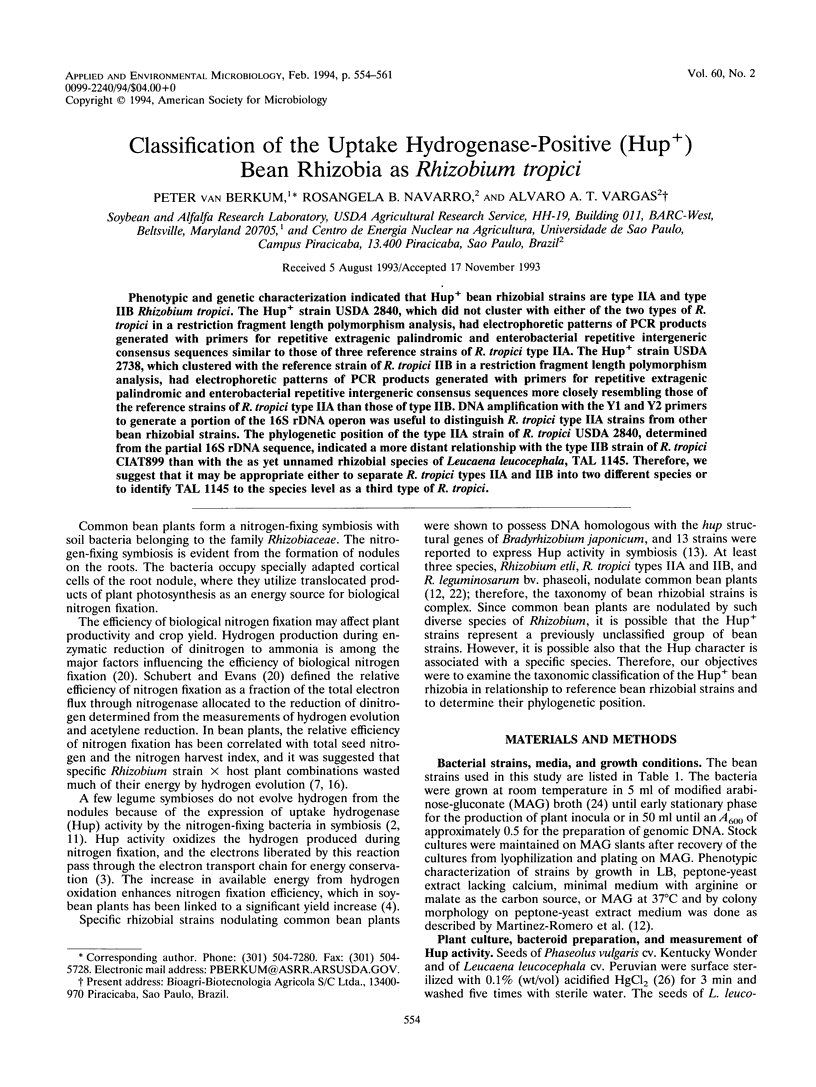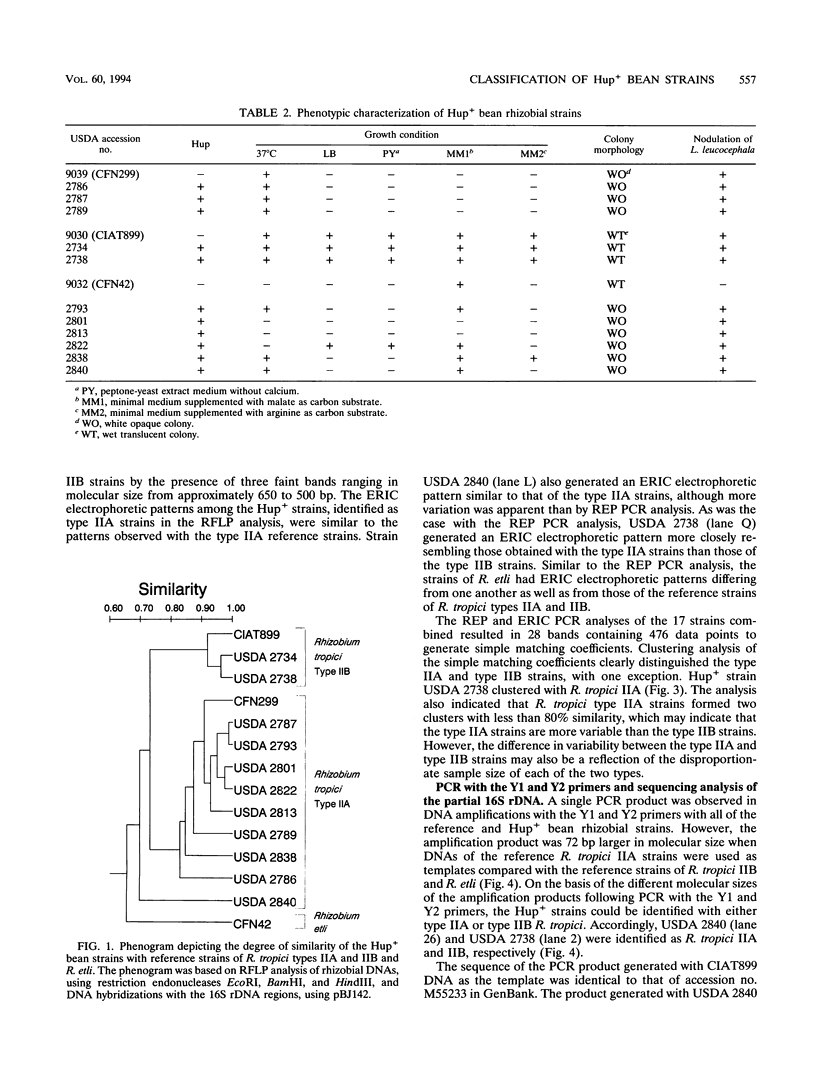Abstract
Phenotypic and genetic characterization indicated that Hup+ bean rhizobial strains are type IIA and type IIB Rhizobium tropici. The Hup+ strain USDA 2840, which did not cluster with either of the two types of R. tropici in a restriction fragment length polymorphism analysis, had electrophoretic patterns of PCR products generated with primers for repetitive extragenic palindromic and enterobacterial repetitive intergeneric consensus sequences similar to those of three reference strains of R. tropici type IIA. The Hup+ strain USDA 2738, which clustered with the reference strain of R. tropici IIB in a restriction fragment length polymorphism analysis, had electrophoretic patterns of PCR products generated with primers for repetitive extragenic palindromic and enterobacterial repetitive intergeneric consensus sequences more closely resembling those of the reference strains of R. tropici type IIA than those of type IIB. DNA amplification with the Y1 and Y2 primers to generate a portion of the 16S rDNA operon was useful to distinguish R. tropici type IIA strains from other bean rhizobial strains. The phylogenetic position of the type IIA strain of R. tropici USDA 2840, determined from the partial 16S rDNA sequence, indicated a more distant relationship with the type IIB strain of R. tropici CIAT899 than with the as yet unnamed rhizobial species of Leucaena leucocephala, TAL 1145. Therefore, we suggest that it may be appropriate either to separate R. tropici types IIA and IIB into two different species or to identify TAL 1145 to the species level as a third type of R. tropici.
Full text
PDF







Images in this article
Selected References
These references are in PubMed. This may not be the complete list of references from this article.
- Emerich D. W., Ruiz-Argüeso T., Ching T. M., Evans H. J. Hydrogen-dependent nitrogenase activity and ATP formation in Rhizobium japonicum bacteroids. J Bacteriol. 1979 Jan;137(1):153–160. doi: 10.1128/jb.137.1.153-160.1979. [DOI] [PMC free article] [PubMed] [Google Scholar]
- Hom S. S., Graham L. A., Maier R. J. Isolation of genes (nif/hup cosmids) involved in hydrogenase and nitrogenase activities in Rhizobium japonicum. J Bacteriol. 1985 Mar;161(3):882–887. doi: 10.1128/jb.161.3.882-887.1985. [DOI] [PMC free article] [PubMed] [Google Scholar]
- Kogan S. C., Doherty M., Gitschier J. An improved method for prenatal diagnosis of genetic diseases by analysis of amplified DNA sequences. Application to hemophilia A. N Engl J Med. 1987 Oct 15;317(16):985–990. doi: 10.1056/NEJM198710153171603. [DOI] [PubMed] [Google Scholar]
- Leonard L. T. A Simple Assembly for Use in the Testing of Cultures of Rhizobia. J Bacteriol. 1943 Jun;45(6):523–527. doi: 10.1128/jb.45.6.523-527.1943. [DOI] [PMC free article] [PubMed] [Google Scholar]
- Martínez-Romero E., Segovia L., Mercante F. M., Franco A. A., Graham P., Pardo M. A. Rhizobium tropici, a novel species nodulating Phaseolus vulgaris L. beans and Leucaena sp. trees. Int J Syst Bacteriol. 1991 Jul;41(3):417–426. doi: 10.1099/00207713-41-3-417. [DOI] [PubMed] [Google Scholar]
- Navarro R. B., Vargas A. A., Schröder E. C., van Berkum P. Uptake Hydrogenase (Hup) in Common Bean (Phaseolus vulgaris) Symbioses. Appl Environ Microbiol. 1993 Dec;59(12):4161–4165. doi: 10.1128/aem.59.12.4161-4165.1993. [DOI] [PMC free article] [PubMed] [Google Scholar]
- O'Brian M. R., Maier R. J. Electron transport components involved in hydrogen oxidation in free-living Rhizobium japonicum. J Bacteriol. 1982 Oct;152(1):422–430. doi: 10.1128/jb.152.1.422-430.1982. [DOI] [PMC free article] [PubMed] [Google Scholar]
- Saitou N., Nei M. The neighbor-joining method: a new method for reconstructing phylogenetic trees. Mol Biol Evol. 1987 Jul;4(4):406–425. doi: 10.1093/oxfordjournals.molbev.a040454. [DOI] [PubMed] [Google Scholar]
- Schubert K. R., Evans H. J. Hydrogen evolution: A major factor affecting the efficiency of nitrogen fixation in nodulated symbionts. Proc Natl Acad Sci U S A. 1976 Apr;73(4):1207–1211. doi: 10.1073/pnas.73.4.1207. [DOI] [PMC free article] [PubMed] [Google Scholar]
- Scott-Craig J. S., Guerinot M. L., Chelm B. K. Isolation of Bradyrhizobium japonicum DNA sequences that are transcribed at high levels in bacteroids. Mol Gen Genet. 1991 Sep;228(3):356–360. doi: 10.1007/BF00260627. [DOI] [PubMed] [Google Scholar]
- Versalovic J., Koeuth T., Lupski J. R. Distribution of repetitive DNA sequences in eubacteria and application to fingerprinting of bacterial genomes. Nucleic Acids Res. 1991 Dec 25;19(24):6823–6831. doi: 10.1093/nar/19.24.6823. [DOI] [PMC free article] [PubMed] [Google Scholar]
- Young J. P., Downer H. L., Eardly B. D. Phylogeny of the phototrophic rhizobium strain BTAi1 by polymerase chain reaction-based sequencing of a 16S rRNA gene segment. J Bacteriol. 1991 Apr;173(7):2271–2277. doi: 10.1128/jb.173.7.2271-2277.1991. [DOI] [PMC free article] [PubMed] [Google Scholar]
- de Bruijn F. J. Use of repetitive (repetitive extragenic palindromic and enterobacterial repetitive intergeneric consensus) sequences and the polymerase chain reaction to fingerprint the genomes of Rhizobium meliloti isolates and other soil bacteria. Appl Environ Microbiol. 1992 Jul;58(7):2180–2187. doi: 10.1128/aem.58.7.2180-2187.1992. [DOI] [PMC free article] [PubMed] [Google Scholar]
- van Berkum P. Evidence for a Third Uptake Hydrogenase Phenotype among the Soybean Bradyrhizobia. Appl Environ Microbiol. 1990 Dec;56(12):3835–3841. doi: 10.1128/aem.56.12.3835-3841.1990. [DOI] [PMC free article] [PubMed] [Google Scholar]




